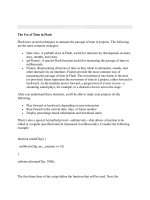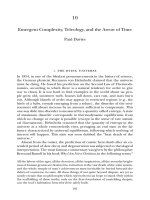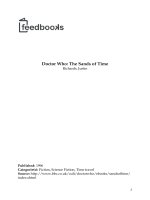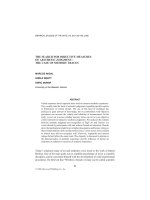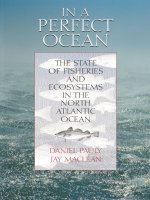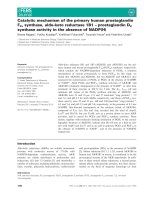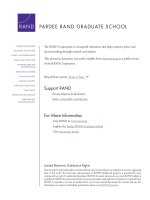- Trang chủ >>
- Khoa Học Tự Nhiên >>
- Vật lý
Perfect symmetry the search for the beginning of time h pagels
Bạn đang xem bản rút gọn của tài liệu. Xem và tải ngay bản đầy đủ của tài liệu tại đây (3.76 MB, 460 trang )
"The fabric of the world has its center everywhere
and its circumference nowhere."
—Cardinal Nicolas of Cusa, fifteenth century
The attempt to understand the origin of the universe is the
greatest challenge confronting the physical sciences. Armed
with new concepts, scientists are rising to meet that
challenge, although they know that success may be far away.
Yet when the origin of the universe is understood, it will
open a new vision of reality at the threshold of our
imagination, a comprehensive vision that is beautiful,
wonderful, and filled with the mystery of existence. It will be
our intellectual gift to our progeny and our tribute to the
scientific heroes who began this great adventure of the
human mind, never to see it completed.
—From Perfect Symmetry
BANTAM NEW AGE BOOKS
This important imprint includes books in a variety of fields
and disciplines and deals with the search for meaning,
growth and change. They are books that circumscribe our
times and our future.
Ask your bookseller for the books you have missed.
THE ART OF BREATHING by Nancy Zi
BETWEEN HEALTH AND ILLNESS by Barbara B. Brown
THE CASE FOR REINCARNATION by Joe Fisher
THE COSMIC CODE by Heinz R. Pagels
CREATIVE VISUALIZATION by Shakti Gawain
THE DANCING WU LI MASTERS by Gary Zukav
DON'T SHOOT THE DOG: HOW TO IMPROVE YOURSELF
AND OTHERS THROUGH BEHAVIORAL TRAINING by
Karen Pryor
ECOTOPIA bv Ernest Callenbach
AN END TO INNOCENCE by Sheldon Kopp
ENTROPY by Jeremy Rifkin with Ted Howard
THE FIRST THREE MINUTES by Steven Weinberg
FOCUSING by Dr. Eugene T. Gendlin
THE HEART OF HEALING by Bruce Davis and
Genny Wright Davis
HERE I AM, WASN'T I!: THE INEVITABLE DISRUPTION
OF EASY TIMES by Sheldon Kopp
HOW TO IMAGINE. A NARRATIVE ON ART AND AGRI-
CULTURE by Gianfranco Baruchello and Henry Martin
I CHING. A NEW INTERPRETATION FOR MODERN
TIMES by Sam Reifler
IF YOU MEET THE BUDDHA ON THE ROAD, KILL HIM!
by Sheldon Kopp
IN SEARCH OF SCHRODINGER'S CAT by John Gribbin
IN SEARCH OF THE BIG BANG: QUANTUM PHYSICS
AND COSMOLOGY by John Gribbin
INFINITY AND THE MIND by Rudy Rucker
KISS SLEEPING BEAUTY GOODBYE by Madonna
Kolbenschlag
THE LIVES OF A CELL by Lewis Thomas
MAGICAL CHILD by Joseph Chilton Pearce
THE MEDUSA AND THE SNAIL by Lewis Thomas
METAMAGICAL THEMAS: QUESTING FOR THE ESSENCE
OF MIND AND PATTERN by Douglas R. Hofstadter
MIND AND NATURE by Gregory Bateson
THE MIND'S I by Douglas R. Hofstadter and
Daniel C. Dennett
ORDER OUT OF CHAOS by Ilya Prigogine and Isabelle
Stengers
PERFECT SYMMETRY by Heinz R. Pagels
PROSPERING WOMAN by Ruth Ross
SPACE-TIME AND BEYOND by Bob Toben and Alan Wolf
SUPERMIND by Barbara B. Brown
SYMPATHETIC VIBRATIONS: REFLECTIONS ON
PHYSICS AS A WAY OF LIFE by K. C. Cole
THE TAO OF LEADERSHIP by John Heider
THE TAO OF PHYSICS, Revised Edition, by Fritjof Capra
TO HAVE OR TO BE? by Erich Fromm
THE TURNING POINT by Fritjof Capra
THE WAY OF THE SHAMAN: A GUIDE TO POWER AND
HEALING by Michael Harner
ZEN AND THE ART OF MOTORCYCLE MAINTENANCE
by Robert M. Pirsig
[This page was intentionally left blank]
Perfect
Symmetry
__________________
The Search for the
Beginning of Time
__________________
Heinz R. Pagels
BANTAM BOOKS
TORONTO • NEW YORK • LONDON • SYDNEY •
AUCKLAND
This low-priced Bantam Book
has been completely reset in a type face
designed for easy reading, and was printed
from new plates. It contains the complete
text of the original hard-cover edition.
NOT ONE WORD HAS BEEN OMITTED.
PERFECT SYMMETRY
A Bantam Book / published by arrangement with
Simon & Schuster
PRINTING HISTORY
Simon & Schuster edition published June 1985
Bantam edition / July 1986
New Age and the accompanying figure design as well as the statement
"a search for meaning, growth and change" are trademarks of
Bantam Books, Inc.
Illustrations by Matthew Zimet.
Cover design by Henrietta Condak
All rights reserved.
Copyright © 1985 by Heinz Pagels.
Cover art copyright ® 1985 by
Simon & Schuster, Inc.
This book may not be reproduced in whole or in part, by
mimeograph or any other means, without permission.
For information address: Simon & Schuster, Inc., 1230 Avenue of the
Americas, New York, NY 10020.
ISBN 0-553-24000-5
Published simultaneously in the United States and Canada
__________________________________________________________________
Bantam Books are published by Bantam Books, Inc. Its trademark,
consisting of the words "Bantam Books" and the portrayal of a rooster,
is Registered in U.S. Patent and Trademark Office and in other
countries. Marca Registrada. Bantam Books, Inc., 666 Fifth Avenue,
New York, New York 10103.
__________________________________________________________________
PRINTED IN THE UNITED STATES OF AMERICA
O 098765432
FOR ELAINE
Acknowledgments
__________________
In preparing this book I have been fortunate in having
friends and colleagues who can offer open criticism or who
have made suggestions that found their way into the text. I
have benefited from comments by Jeremy Bernstein, John
Brockman, Malcolm Diamond, John Faulkner, Randall
Furlong, George Greenstein, Alan Guth, Edward Harrison,
Joseph H. Hazen, Nicolas Herbert, James McCarthy, Richard
Ogust, Jim Peebles, Anthony Tyler and Anthony Zee. I am
especially grateful for the detailed criticism of George Field
and Engelbert Schucking in the sections of the book dealing
with astrophysics and cosmology. Alice Mayhew and
Catherine Shaw did the major editorial work on the text and
helped turn my English into English. Matthew Zimet's
inventive illustrations delight the eye and do much to
enhance the text. Finally, I want to thank the Board of
Governors of The New York Academy of Sciences for their
sympathetic appreciation of my interest in science writing.
Contents
_________
FOREWORD xiii
ONE HERSCHEL'S GARDEN 1
1 Herschel's Garden 3
2 The Birth and Life of Stars 11
3 The Death of Stars: Astronecroscopy 38
4 The Discovery of Galaxies 69
5 Radio Galaxies and Quasars 101
6 Why Is the Universe Lumpy? 117
7 Classical Cosmology 132
TWO THE EARLY UNIVERSE 155
1 The Early Universe 157
2 Fields, Quanta and Symmetry 169
3 The Standard Model 208
4 Thermodynamics and Cosmology 234
5 The Big Bang 244
THREE WILD IDEAS 269
1 Unified-Field Theories 271
2 Magnetic Monopoles 296
3 Unifying Gravity 313
4 Before the Big Bang: The Inflationary Universe 331
5 Before Inflation: The Origin of the Universe 353
FOUR REFLECTIONS 369
1 The Cosmic Computer 371
2 First-Person Science 380
BIBLIOGRAPHY 392
INDEX 399
In the beginning God created the heavens and the earth.
The earth was without form and void and darkness was
upon the face of the deep; and the spirit of God was
moving over the face of the waters.
—Genesis
[This page was intentionally left blank]
Foreword
__________
The children's books that were my first contact with the
universe opened my imagination to thoughts of voyages to
the moon, planets and stars. When I was older, however, I
visited the Fels Planetarium in Philadelphia and the Hayden
Planetarium in New York, and that simple, self-centered
perception was shattered. The drama and power of the
dynamic universe overwhelmed me. 1 learned that single
galaxies contain more stars than all the human beings who
have ever lived, and I saw projections of clusters of such
galaxies moving in the void of space like schools of fish
swimming in the sea. The reality of the immensity and
duration of the universe caused a kind of "existential shock"
that shook the foundations of my being. Everything 1 had
experienced or known seemed insignificant placed in that
vast ocean of existence.
While my sense of awe at the size and splendor of the
universe is a feeling that has never quite left me, reflecting
back on my childhood experience I see that the universe
provided a screen upon which I could project my feelings
about the immensity of existence; that external ocean
mirrored the one within me. Later, as I pursued the study of
theoretical physics at Princeton and Stanford Universities,
my attitude toward the universe altered. The universe
became less a screen for the projection of my feelings and
more a puzzle challenging me as a scientist, a puzzle which
left scattered, complex clues to its solution. The universe, in
spite of its size, is a physical entity governed by the laws of
space, time and matter. Someday (and that day is not
xiii
xiv PERFECT SYMMETRY
yet here) physicists may know the laws that describe the
creation of the universe and its subsequent evolution. The
logical account of the foundations of physical existence will
then be complete.
As we embark on the study of the universe, it is worth
reminding ourselves that not so long ago, at the beginning of
this century, physicists were puzzled by the properties of
atoms. Atoms were so small (a few eminent scientists even
doubted their existence) and behaved in such sporadic,
uncontrollable ways that some people thought they lay
beyond the power of scientific comprehension. Yet after
major experimental and theoretical discoveries, physicists in
the 1920s invented the quantum theory which explicated the
weird world of the atom. New and unfamiliar physical
concepts were incorporated into the quantum theory,
concepts that have survived to the present day.
Similarly, as physicists attempt to comprehend the origin
and evolution of the universe, they will certainly need to
invent new and unfamiliar concepts. Scientists do not yet
understand the fundamental laws that describe the very
origin of the universe, at least not as well as they understand
the laws describing atoms. But many scientists today are
excited because such an understanding is currently in the
making, a result of the intellectual synthesis of two scientific
disciplines: quantum theory, which specifies the laws of the
smallest things—the quantum particles—and cosmology,
which specifies the laws that govern the largest thing—the
entire universe.
A major reason for the growing intimacy between quantum
physics and cosmology is the success of the "big bang"
theory of the early universe. According to this theory, if we
imagine going backward in time then we would see the
universe contract, the galaxies move closer together until
they meld into a hot, uniform gas of all the constituents of
matter—the quantum particles—interacting at enormous
energy. Elucidating the properties of such a gas of hot,
interacting quantum particles is the purview of modern
quantum theory. Physicists estimate that the high
temperatures and high energies among the quantum
particles eventually encountered in the early universe are
physically unique—they become so high that they cannot be
reproduced in laboratories here on earth. Hence the only
possible "laboratory" that can test theories of quantum-
FOREWORD xv
particle interactions at ultrahigh energies is the universe
itself.
Another reason for the growing intimacy between quantum
theory and astronomy is that astronomers are now observing
exotic objects like neutron stars, consisting of matter
compressed to enormous densities, and possibly black holes,
in which the very fabric of space and time undergoes
unusual distortions. Like the early universe, these strange
objects present extreme physical conditions that cannot be
reproduced here on earth. Since it is the properties of space,
time and matter, especially under extreme conditions, that
physicists endeavor to understand, these new objects
provide yet additional extraterrestrial laboratories for
testing physical laws.
Were I to summarize the optimistic theme of this book in a
single sentence, that sentence would be "From microcosm to
macrocosm, from its origin to its end, the universe is
described by physical laws comprehensible to the human
mind."
I believe that physicists will someday soon understand the
basic laws of the quantum creation of the universe (most
probably out of nothing whatsoever) as well as
astrophysicists now understand the interiors of stars. The
universe, whose very mention invokes a sense of
transcendence, will be comprehended as subject to natural
laws like all other material things. In spite of its immensity
and age, the universe will never seem the same.
Such a fulfillment of the program of the natural sciences will
have a profound impact on human thinking. As knowledge
of our universe matures, that ancient awestruck feeling of
wonder at its size and duration seems inappropriate, a
sensibility left over from an earlier age. Thousands of years
ago, many people perceived the sun as a divine presence;
today many people perceive the universe as essentially
beyond human comprehension. But just as the sun is now
understood in terms of astrophvsical processes, so too will
the universe be similarly understood. In the past, myths and
the religious creation stories shaped the values of people
who believed in them; likewise the emergent scientific
cosmology will shape the values of those who accept it.
Through the agency of scientific discovery the external
order of the universe influences our consciousness and
values.
xvi PERFECT SYMMETRY
This book is divided into four parts. The first part,
"Herschel's Garden," gives the reader an overview of the
dynamic universe discovered by astronomers—the stars,
white dwarfs, neutron stars, black holes, interstellar gas and
dust, quasars, galaxies, their distribution in space as clusters
and superclusters of galaxies, and the cosmos as a whole.
From this part of the book the reader should derive a sense
not only of the size of the universe and our knowledge of its
inhabitants but also of the puzzles confronting modern
astronomy such as how stars are born and galaxies are
evolving. I discuss some suggested solutions to these and
other astronomical puzzles to which we can hope to achieve
a final resolution as new observational data are acquired.
Today, the search into the universe continues with
instruments like satellites and radio telescopes, a search
manifesting, in the words of the American astronomer
Edwin Hubble, an "urge older than history."
While the first part of the book describes the universe
observed in space, the following two parts of the book
describe a conceptual exploration of the universe in time.
The second part, "The Early Universe," describes the
remarkable picture of the universe when it was only seconds
and minutes old—the "hot big bang," a theory that came
about by the application of the laws of quantum-particle
physics to the entire universe. Without using complicated
mathematics I describe the basic framework for thinking
about the quantum particles—die discipline known as
"relativistic quantum-field theory"—and how it applies to
the study of the early universe. Amazingly, physicists
understand the universe better when it was seconds and
minutes old than for either earlier or later times because
when it was seconds old the universe was a uniform, rather
simple, gas of quantum particles, whose properties are
known. The early universe is better understood than the
weather is today.
But the very success of the hot-big-bang theory gives
physicists the confidence to press onward and conceptually
explore the universe before the first nanosecond (one-
billionth of a second) to the very origin of the universe. The
third part of the book, "Wild Ideas," leaves the secure
territory explored by astronomical observation and by high-
energy laboratory experiments and speculates about the
nature of that universe before the first nanosecond. I
FOREWORD xvii
discuss "wild ideas" in the conceptual repertoire of
theoretical physicists that might explicate the dynamics of
the very early universe, ideas such as GUTs—grand unified
theories—magnetic monopoles, supersymmetry and the
world of many extra dimensions. If these ideas are correct—
and many physicists think they are—then an amazing
picture of the very early universe results.
The universe begins in a very hot state of utmost simplicity
and symmetry and as it expands and cools its perfect
symmetry is broken, giving rise to the complexity we see
today. Our universe today is the frozen, asymmetric remnant
of its earliest hot state, much as complex crystals of water
are frozen out of a uniform gas of water vapor. I describe the
inflationary universe—a conjectured pre—big-bang epoch of
the universe, which may explain some puzzling features of
the contemporary universe, such as its uniformity and age,
as well as provide an explanation for the origin of the
galaxies. The penultimate chapter of this third part of the
book—as far as speculation is concerned— describes some
recent mathematical models for the very origin of the
universe—how the fabric of space, time and matter can be
created out of absolutely nothing. What could have more
perfect symmetry than absolute nothingness? For the first
time in history, scientists have constructed mathematical
models that account for the very creation of the universe out
of nothing.
There is a short fourth part, "Reflections," which expresses
my opinions and attitudes (not that the other parts of the
book do not contain many of my opinions or intellectual
biases as a theoretical physicist). Here the reader will find a
chapter developing the metaphor of the universe as a cosmic
computer for which the quantum particles are the
"hardware," the laws of physics the "software" and the
evolution of the universe is the execution of the program. In
a Final chapter called "First-Person Science," I explore the
thoughts and feelings that a few People have had about the
meaning of our strangely coherent universe.
New York, New York Felton, California 1984
[This page was intentionally left blank]
One
____
Herschel’s
Garden
___________
The most beautiful and deepest experience a man can
have is the sense of the mysterious. It is the underlying
principle of religion as well as of all serious endeavour
in art and in science. He who never had this experience
seems to me, if not dead, then at least blind. The sense
that behind anything that can be experienced there is a
something that our mind cannot grasp and whose beauty
and sublimity reaches us only indirectly and as feeble
reflexion, this is RELIGIOUSNESS. In this sense I am
religious. To me it suffices to wonder at these secrets
and to attempt humbly to grasp with my mind a mere
image of the lofty structure of all that there is.
—Albert Einstein, 1932
1
__
Herschel’s Garden
__________________
There are two kinds of happiness or contentment for
which we mortals are adapted; the first we experience in
thinking and the other in feeling. The first is the purest
and most unmixed. Let a man once know what sort of a
being he is; how great the being which brought him into
existence, how utterly transitory is everything in the
material world, and let him realize this without passion
in a quiet philosophical temper, and 1 maintain that then
he is happy; as happy indeed as it is possible for him to
be.
—William Herschel,
from a letter to his brother Jacob
William Herschel, the greatest astronomer of the eighteenth
century, began his career as a teenage oboist in the
Hanoverian Foot Guards in a part of Germany then under
the dominion of George II of England. Born in 1738, he
wanted to become a professional musician and composer.
However, at about the time of the battle of Astenbeck he was
"so near to the field of action as to be within reach of
gunshot." His father advised him to flee. To avoid the draft
into regular military service, he left at age nineteen with his
brother Jacob for England, where he pursued his career in
music. In 1766, he was appointed organist at the
3
4 PERFECT SYMMETRY
Octagon Chapel in the resort town of Bath, where he also
played in the Pump Room orchestra.
Not until he was thirty-five did Herschel's interest in
astronomy begin. In Bath he bought many books on
astronomy. Aided by his sister, Caroline, and brother
Alexander, he made a fine reflecting telescope using a
foundry he built in his house. No doubt his skill with
musical instruments served him well in the construction of
the precision instrument. Training this telescope at the sky,
he discovered a new planet—Uranus—which he at first
thought was a comet. Since ancient times the only known
planets had been the six observable by the unaided eye. No
one had anticipated an additional planet, and the shock of
this discovery made Herschel and his telescope instantly
famous. Not at a loss to express his gratitude to his adopted
country, he called the new planet Georgium Sidus (George's
Star) in honor of King George III, but later the name was
changed. Herschel was elected to the Royal Society of
London, George III became his patron and his career in
astronomy was launched.
Herschel's entry into astronomy was not unusual—many
great observational astronomers began their careers in
different professions with only an ancillary interest in
astronomy. But after making the major astronomical
discovery of a strange new planet, Herschel found it difficult
to resist the urge to continue exploring the universe. The
passion for science and the passion for music are driven by
the same desire: to realize beauty in one's vision of the
world.
Herschel's accomplishments in astronomy are all the more
remarkable in retrospect; indeed, many of his observations
and insights could not be fully appreciated until the
twentieth century. He realized, for example, that because of
the finite velocity of light we see distant celestial objects as
they were in the past. As we look into the depths of the
universe, we look at the way it was millions and billions of
years ago when the light we are now receiving was first
emitted. Remarkably, the universe contains the record of its
past the way that sedimentary layers of rock contain the
geological record of the earth's past. And that fact opened
the window to the evolutionary view of the universe held
today.
HERSCHEL’S GARDEN 5
Herschel became obsessed with the problems of
determining the structure of the Milky Way and locating the
position of our sun within it. He was even convinced that
some nebulae were both external to the Milky Way and
similar to it—thus anticipating the "island universe" theory
of galaxies. Because it was impossible to estimate distances
to the stars with the techniques available to Herschel, his
picture of the Milky Way galaxy was quantitatively wrong.
Much to his credit as a scientist, but to his personal
disappointment, he later abandoned his picture of the Milky
Way as a large disk (which is in fact correct) when he
realized that his observational methods were inadequate for
the task of accurately establishing its shape. But he was the
first to show that the Milky Way stars are not symmetrically
arranged about the sun—an important fact substantiated by
modern observations. He thus destroyed forever the idea of
the heavens as a celestial sphere surrounding the sun. In
spite of subsequent speculations, no further progress on this
problem was made until Harlow Shapley, the American
astronomer, published his studies on the shape of the Milky
Way some 140 years later.
On the day of his election to the Royal Society, Herschel was
sent a copy of the new catalogue of 103 nebulae published
by Charles Messier and Pierre Mechain by his friend Dr. W.
Watson, Jr. He immediately began to train his wonderful
telescope upon these strange objects, hoping to discover a
few more that might have been missed.
Instead, he discovered two thousand new nebulae and
began a list of his own. This was the beginning of a new
catalogue (to which his son, John, added the many more
nebulae he observed in the southern hemisphere some
years later) and formed the foundation of all the modern
catalogues of galaxies.
Herschel also discovered many double-star systems— two
stars in orbit about each other—and showed that they obey
Newton's law of gravitation. Today we know that about half
of all observable stars are members of such binary systems.
Herschel's discovery that Newton's law applies to the
movement of faraway stars, and not just to the movement of
planets about the sun, was pivotal. He also showed that the
sun, rather than being fixed in space,
6 PERFECT SYMMETRY
actually moves, in this case toward the star Lambda
Herculis—a revolutionary idea comparable to Copernicus'
declaration that the earth moves about the sun. Like many
of his contemporaries, Herschel thought the moon, the
planets and the sun were inhabited (he thought there was a
cool surface under the sun's hot atmosphere). Perhaps no
person before or since has spent so much time looking
through a telescope.
Herschel made a great conceptual shift in astronomy.
Previously people shared a Newtonian, mechanical view of
the stars as subject only to the force of gravity. But Herschel,
thoroughly in tune with our modern view, suggested that
other dynamic processes were shaping the universe. In the
baroque style of his time, he writes about the possibility of
old stars colliding to form new ones:
If it were not perhaps too hazardous to pursue a former surmise of a
renewal in what I figuratively call the Laboratories of the Universe,
the stars forming these extraordinary nebulae, by some decay or
waste of nature, being no longer fit for their former purposes, and
having their projectile forces, if any such they had, retarded in each
other's atmosphere, may rush at last together, and either in
succession, or by one general tremendous shock, unite into a new
body. Perhaps the extraordinary and sudden blaze of a new star in
Cassiopeia's chair, in 1572, might possibly be of such a nature.
Herschel appreciated the vast variety of the heavens— even
in his time, when the observed universe was far simpler
than what we behold today. He saw the universe as a
changing, evolving place and said that examining the stars
was like examining a large garden in which some plants are
old, others young, some are being born, others are dying.
Although we may not see an individual plant growing, we do
see lots of examples of that plant in all stages of its life, and
that observation gives us a clue to understanding its growth.
Likewise, the astronomer sees an evolutionary continuum in
the development of stars, and perhaps in galaxies and
clusters of galaxies, and that is his clue to the dynamics of
change in the universe. Herschel wrote:

